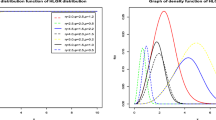A subclass of lattice conditional independence models is introduced. The new class of models is called totally ordered independence models. The class is based on an assumption that the index set which orders the random variables is a chain. It is shown that there is a jump in the chain if and only if there is a conditional independence relation. Some comparisons between the lattice conditional independence models and totally ordered independence models are presented.
Similar content being viewed by others
References
S. A. Andersson, D. Madigan, M. D. Perlman, and Ch. M. Triggs, “On the relation between conditional independence models determined by finite distributive lattices and by directed acyclic graphs”, J. Statist. Plann. Inf., 48, 25–46 (1995).
S. A. Andersson, J. I. Marden, and M. D. Perlman, “Totally ordered multivariate linear models,” Sankhyā Ser. A, 370–394 (1993).
S. A. Andersson and M. D. Perlman, “Lattice models for conditional independence in a multivariate normal distribution,” Ann, Statist., 1318–1358 (1993).
S. A. Andersson and M. D. Perlman, “Normal linear models with lattice conditional independence restrictions,” Multivariate analysis and its applications (Hong Kong, 1992), 97–110, IMS Lecture Notes Monogr. Ser., 24, Institute of Mathematical Statistics, Hayward, CA, 1994.
S. A. Andersson and M. D. Perlman, “Normal linear regression models with recursive graphical Markov structure,” J. Multivar. Anal., 66, 133–187 (1998).
G. Grätzer, General Lattice Theory. With appendices by B. A. Davey, R. Freese, B. Ganter, M. Greferath, P. Jipsen, H. A. Priestley, H. Rose, E. T. Schmidt, S. E. Schmidt, F. Wehrung and R. Wille. Reprint of the 1998 second edition. Birkhäuser Verlag, Basel, 2003.
S. L. Lauritzen, “Graphical models,” Oxford Statistical Science Series, 17. Oxford Science Publications. The Clarendon Press, Oxford University Press, New York, 1996.
S. L. Lauritzen and Th. S. Richardson, “Chain graph models and their causal interpretations,” J. Royal Statist. Soc. Ser. B Statistical Methodology, 64, 321–361 (2002).
T. S. Richardson, “A characterization of Markov equivalence for directed cyclic graphs. 1996 Uncertainty in AI (UAI ’96) Conference,” Inter. J. Approx. Reasoning, 17, 107–162 (1997).
Author information
Authors and Affiliations
Corresponding author
Additional information
Published in Zapiski Nauchnykh Seminarov POMI, Vol. 501, 2021, pp. 102–117.
Rights and permissions
Springer Nature or its licensor (e.g. a society or other partner) holds exclusive rights to this article under a publishing agreement with the author(s) or other rightsholder(s); author self-archiving of the accepted manuscript version of this article is solely governed by the terms of such publishing agreement and applicable law.
About this article
Cite this article
Gauraha, N., von Rosen, D. Totally Ordered Conditional Independence Models. J Math Sci 273, 722–731 (2023). https://doi.org/10.1007/s10958-023-06535-6
Received:
Published:
Issue Date:
DOI: https://doi.org/10.1007/s10958-023-06535-6




